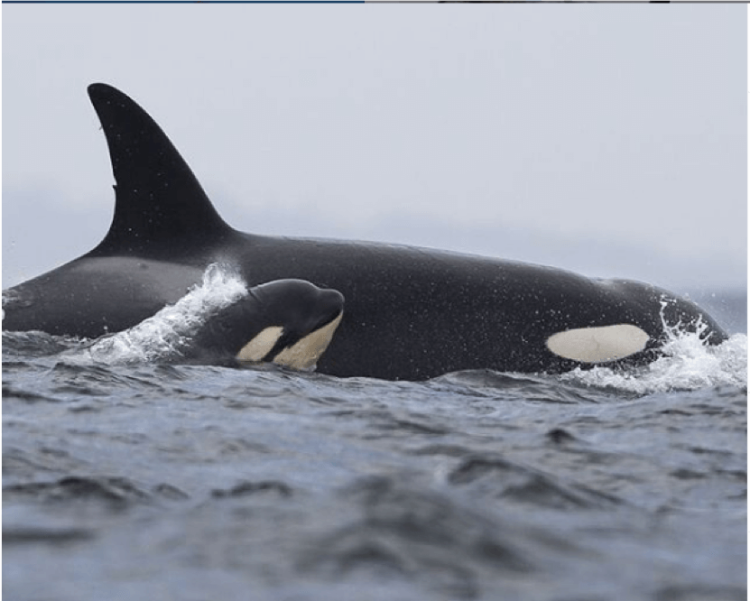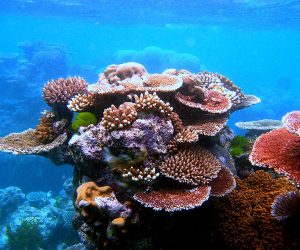
The Life of Orcas
Orcas, also known as killer whales, are one of the most distinctive and unique marine creatures – distinguished for their black and white patterns and intelligence. Yet, the life of orcas, their history and their importance to the marine ecosystem are less known.
Orcas, or killer whales, are one of the most distinctive and unique marine creatures.
Bodies – Shapes and Sizes
Orcas, as humans, are mammals: they breathe air from the atmosphere and females produce milk for feeding their young. Contrary to what their name suggests, killer whales do not belong to the family of whales; instead, they belong to the family of dolphins being the largest dolphin.

Orcas can reach a body length up to 9 meters in males -and weigh 6600 kilograms- and 7.7 meters in females. Mature males present larger extremities than females in which the dorsal fin can attain a height of 1.8 meters. Newly born orcas have a body length of up to 2.5 meters and weight 200 kilograms – pretty big for a newborn!
Orcas are the largest dolphins – not whales – that can reach a body length up to 9 meters.

Distribution and Habitat
Orcas are the most widely distributed marine mammal in the world, extending their habitat from the Arctic to the Antarctic – even found in river mouths. However, orcas are more common in coastal, temperate waters, particularly in areas of high marine productivity.

The orca is the second only to humans as the most widely distributed mammal in the world – even found in river mouths.
Population
The minimum worldwide abundance estimate of orcas is 50,000 individuals. Yet, not all orcas are the same. The most studied population of orcas worldwide, in the northeastern Pacific, have revealed that three ecotypes of orcas exist. These ecotypes differ in body size, colour patterns, habitat, prey preferences, behaviour, acoustics and genetics. These ecotypes sometimes co-exist in the same environment; yet they are socially and reproductively isolated from each other which is very unique among mammals.
50,000 orcas are found worldwide; yet no all orcas are the same. Three ecotypes have been found in northeastern Pacific.

Life History of Orcas
Humans and orcas share much in common. As humans, female orcas give birth for the first time at 14 or 15 years old. As humans, single young are usually born; although a set of twins is possible – but rare.
Orcas gestation period is between 15 to 18 months. Mortality on calves is high: 40% of orcas die in the first six months of life. They start weaning at an age likely between 1 and 2 years old. Females have an average of 5 successful offsprings over a 25-year reproductive life-span, which ends at approx. 40 years, when menopause starts.

Female orcas live to approximately 50 years, yet some may reach 80-90 years of age. Males attain sexual maturity at approx. 15 years, and continue to grow until they reach 21 years. A male Orca’s lifespan is shorter, averaging about 30 years and can reach up to 50–60 years.
The known causes of orca mortality are few, these are related to the risks they take while capturing their prey; stranding as a result of chasing their prey in shallow waters and stingray spine injury as a result of attacking stingrays.

| Life-History traits | Humans | Orcas |
| First time to give birth (age) | 14 or 15 years old | |
| Number of young born | 1 young (twins, rare) | |
| Gestation period (months) | 9 | 15 to 18 |
| Reproductive life-span | 25 years | |
| Longevity (years) | up to 100 | up to 90 |
The life of orcas and humans have a lot of similarities. We have similar cosmopolitan range, we are mammals that feed our young with milk, become reproductively active and later inactive at the same age, give birth to one young, sometimes twins, live up to 90 years, and like us, orcas are the top predators.
Top Ocean Predators
Orcas are the top predators of the ocean: they have no natural predators other than humans – they even attack the great white sharks! They prey upon a great diversity of animals, over 140 species: marine mammals (sea lions, sea otters, dolphins, whales), fish (salmon, herring, cod, tuna), sharks, rays, squids, octopuses, sea turtles, and sea birds. Orcas even prey upon deer and moose which are caught swimming across channels.
Orcas, the ocean top predator: they have no natural predators, prey over 140 species including great white sharks and moose.

Foraging Specialization
Because orcas feed on more than 140 species, they are considered generalist predators. Yet, orcas at specific geographic locations have specialized in certain prey. For example, in the northeastern Pacific, the three ecotypes have a specialized diet: one ecotype has a coastal habitat and specializes in fish, other specializes in hunting marine mammals, and the other ecotype has an offshore habitat and prey on fish.
Orcas are specialist predators. Some groups have specialized in hunting and preying on marine mammals, including humpback whales.

The Tale of the Whales Tail
Killer whales have their name for a reason: they kill whales. The tail of the humpback whale, known as fluke, is marked for life by scars which are a detailed story of survival. This scar, known as tooth rake mark, is the evidence of an orca attack on a humpback which is made by teeth orcas in a humpback‘s fluke. Researchers know now that these attacks took place when humpbacks were calves, these are easy prey compared to adults.
Researchers have discovered that up to 40% of humpbacks have rake marks in their flukes, implying that orcas are attacking humpbacks around the world. Scarring is an evidence of either the prey’s ability to escape, or the predator’s inefficiency, or both and obviously not the result of a successful attack. Yet, attacks can have a successful outcome for killer whales: in Western Australia, killer whales attacked and killed humpback calves in 64% of attack outcomes observed.

These attacks to humpback whales might be rising. Since 1986 whales and dolphins have been protected against whaling. As a result today, 9 of 14 populations of humpbacks no longer require protection. Because humpback numbers are rising, orcas have more food. According to researchers we are now getting a snapshot of how the oceans functioned before whaling and beginning to understand what happens when one cetacean attacks another. Before whaling, orca predation on humpback calves might have been more common then and now is coming back. The story of life is forever evolving, and this dramatic story about the life of orcas is the result of conservation in action.
When killer whales attack humpback whales, they leave a scars, known as tooth rake marks. Researchers now know that these attacks can be highly successful and are rising. As humpbacks increase in numbers, orcas have more food.

Importance of Orcas in the Marine Ecosystem
Top predators play an important role in the structure and function of ecosystems. In the northeastern Pacific, human activity in the 70`s caused a cascading effect in the marine ecosystem that started with their top predator. Orcas didn’t have enough food, since their usual prey, seals and sea lions, where diminishing probably due to reduction in population of certain fish species and prey like seals and sea lions. As a result, orcas switch their prey to sea otters, a keystone species for the kelp forest. Therefore, the sea otter population diminished and this had a cascading effect in the kelp forest ecosystem. Since sea otters feed on sea urchins; these invertebrates increase in number and over-graze on kelp which had a terrible effect on the whole ecosystem that depends on kelp for its survival.
Orcas as top predators play an important role in structure and function of marine ecosystems. Overfishing can have a cascading effect that starts with orcas and ends in kelp forest.
Conservation
According to the International Union for Conservation of Nature, orcas are ‘data deficient’ because of the likelihood that two or more orca types are separate species. Historically, killer whales have been the target of directed fisheries, culling, and persecution, some to reduce competition for other fisheries. Today, orcas are protected in most oceans.
A love story: today, orcas are protected in most oceans.
Threats
Other threats still prevail. As top predators, orcas are susceptible to biomagnification of human-made toxins, such as polychlorinated biphenyls (PCBs). Levels of PCBs in orcas from the Northeastern Pacific have been shown to be among the highest observed in any cetacean. These can affect the health of orcas through reduced reproductive success and suppression of their immune system. Climate change might also be impacting the life of orcas. Models predict major reductions in sea ice. Orcas may move into northern waters as sea ice disappears, and as a top predator, orcas may initiate major ecosystem adjustments, becoming major players in the reorganization of Arctic oceans.
Orcas, as top predators are vulnerable to biomagnification of toxins that affect their health. Climate change is also impacting the life of orcas in new ways we are just unveiling.
Biomagnification is the process by which a compound increases its concentration in an organism’s tissue as it travels up the food chain.
Conclusion
Orcas are our counterpart in the oceans. Like us, they have conquered our Blue Planet. Like us, they present similar life history traits. Like us, they are the top predator of the oceans. Humans have numerous encounters with orcas in the wild; yet no fatal attack has ever been registered. This intelligent, social and sensible creature must recognize themselves in us. As we feel a strong connection with orcas, they must feel a strong connection with us.
Humans have numerous encounters with orcas in the wild; yet no attack has ever been registered.
Sources
- Ford, John K. B.. Killer Whales : The Natural History and Genealogy of Orcinus Orca in British Columbia and Washington, UBC Press, 1993.
- J. A. Estes, M. T. Tinker, T. M. Williams, D. F. Doak. 1998. Killer Whale Predation on Sea Otters Linking Oceanic and Nearshore Ecosystems. Science. 282 (16): 473-475.
- Capella, J., F. Félix, L. Florez-Gonzalez, J. Gibbons, B. Haase and H. M. Guzman. 2018. Geographic and temporal patterns of non-lethal attacks on humpback whales by killer whales in the eastern South Pacific and the Antarctic Peninsula. Endang. Species Res. 37:207–218.
- Mehta, A. V. 2004. How important are baleen whales as prey for killer whales (Orcinus orca ) in high latitudes? MA thesis, Boston University
- Pitman, R. L., J. A. Totterdell, H. Fearnbach, L.T. Ballance, J.W.Durban, andH.Kemps. 2015. Whale killers: Prevalence and ecological implications of killer whale predation on humpback whale calves off Western Australia. Mar. Mammal Sci. 31:629– 657.
- Duignan et al. 2000. Stingray spines: A potential cause of killer whale mortality in New Zealand. Aquatic Mammals. 26(2): 143–147


